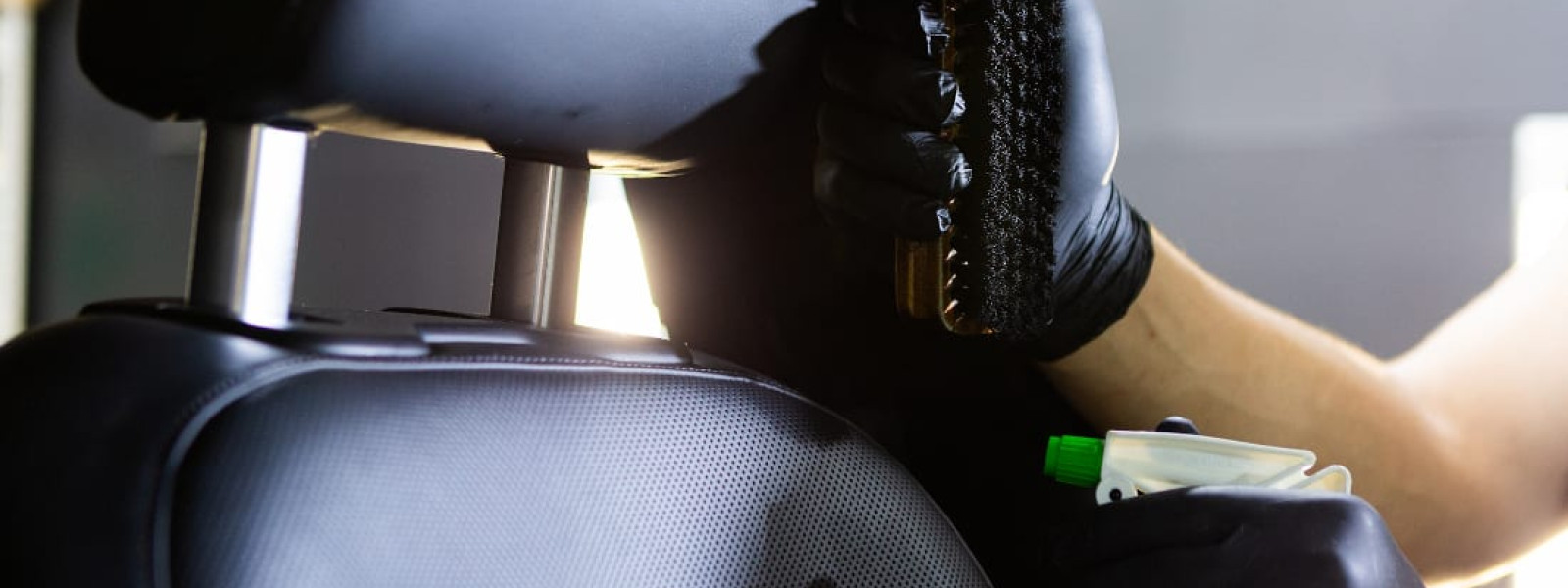How to clean a leather car interior?

No matter the car, cleaning the leather in your vehicle takes time, dedication and a steady hand. It is an art but expertise that can be learned through seasoned practice. Whether you are driving a classic Bentley or the latest Land Rover, leather seats can be cleaned and conditioned to bring life back to your car’s interior. So, let’s learn how to care for a leather car interior the right way. But, first, we need to figure out what kind of leather you have in your vehicle.
Type of Leather
Before jumping in and considering the best leather conditioner for your car’s interior, let’s chat about the type of leather in your vehicle. There are four types of genuine leather seats on the market today. Those being:
Aniline
Aniline leather is a rarity in today’s luxury vehicles, but it was all the rage a decade or two ago. This kind of leather is known for its natural look and gorgeous patterns; however, as it lacks any protective coating or layers, the material struggles with normal wear and tear, making it less than ideal for a vehicle.
Semi-Aniline
Related to aniline leather, semi-aniline leather has natural color added to it, strengthening and adding an extra layer of protection to the material. Known for its smooth look, semi-aniline leather is otherwise called finished leather. The vast majority of high-end and luxury cars use this leather type in their vehicles.
Corrected Grain Leather
Typically found in mainstream vehicles, corrected grain leather has the least authentic genuine leather product on the market. The leather is treated to remove imperfections and then is coated and labelled with a pattern. This type of leather is designed to take a beating and still look great.
Full-Grain
Known for its durability and sumptuous feel, full-grain leather has quickly become the exclusive choice for many luxury automakers. With its tanned and coated finish, full-grain leather will keep its natural markings and patterns for years to come.
How to clean your leather seats
Now that we have taken a look at the different kinds of leather that your vehicle might have let’s look at how you might clean your leather car interior. Most vehicle seats should be lightly-cleaned once a month and deeply-cleaned one every four months. Remember, when it comes to cleaning your car’s leather interior, the devil is in the details.
Grab the shop-vac
The first step in cleaning your car’s leather interior is to vacuum your seats. No matter the type of leather, make sure to be careful not to scratch your leather. To get to those tough to reach spots, such as the seat cracks, use an air compressor to blow out the dirt and dust.
Tackle the dirt
Using a natural leather cleaner or your own car interior leather cleaner, spray a microfiber cloth and wipe down the seats. Make sure not to dip the microfiber cloth into the solution or spray the cleaner directly on the seats; you don’t need much cleaner to get the job done right. Once the surface dirt is tackled, you can use a brush to deep-clean the leather with the cleaner. When choosing your brush, make sure to use a soft-bristled head to avoid any scratches. Finally, you can finish off with another wipe down with your microfiber cloth to remove any remaining dirt on the seats.
Wipe clean
Using an additional clean microfiber cloth, scrub down your leather seat. You will notice dirt, oil, and even grime on the cloth; this is normal. Make sure to try and get as much off as possible, and take the time to go into the crevices.
The art of conditioning
Leather seats need tender and loving care, and no matter if you are completing a Bentley car maintenance or a quality Land Rover service, your seats need attention. Generally, you will only want to condition your seats a couple of times per year. Conditioning is essential in caring for your leather car interior, and here is how to do it!
Use the right conditioner
Make sure to find and use a water-based neutral conditioner without silicone, waxes or petroleum products. The goal of conditioning is to replenish natural oils in the leather, and cheaper conditioners may leave a greasy finish.
Time to condition
Apply the conditioner to the seats, and using a microfiber cloth, start to massage and rub the conditioner into the seats. You want to be careful not to use too much, so be careful and sparing with your application. Continue to massage and rub until the conditioner is gone and your seats are no longer slick or greasy.
Find some shade!
Conditioning takes a few hours to set, so you will want to find a shaded parking spot or an underground parking lot. Avoid direct sun as UV can affect the process.
Buff the seats
After an hour, or more, take a clean microfiber cloth and polish your seats. When shining, use a circular motion with the cloth and a fair bit of elbow grease. You want those seats sparkling! You can also use a buffing cloth, but microfiber is an excellent substitute if you don’t have one.
Whether you are cleaning your car’s interior for the first-time or a seasoned veteran, the process is the same. Make sure to take the time to ensure that you find a natural car leather interior cleaner, quality cloths and brush heads, and enough time to do the job right. Cleaning leather is a fine art. You don’t even need to know how to remove your interior car trim to do it right!
So, no matter your vehicle, no matter the wear and tear, your leather seats need some love, and now you can get it done yourself. Avoid using harsh chemicals and industrial leather cleaners. Your leather seats need only you, some natural cleaning products and cloth. Now go give some life back into those well-used leather seats!